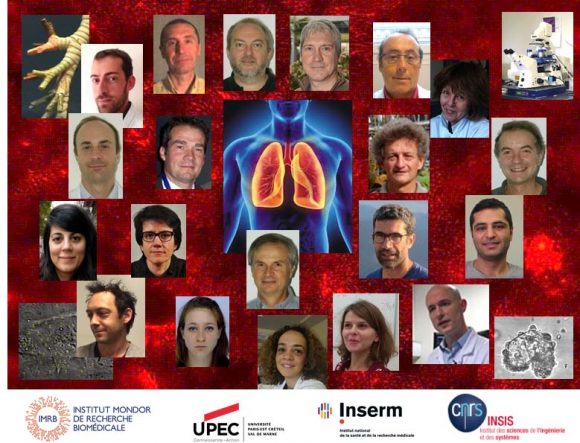Biomechanics & respiratory apparatus
 Research topic :
Research topic :
Our team develops a multidisciplinary research at the interface between biomechanics, bioengineering, and biomedical sciences. Our program is dedicated at further deciphering the physiological and pathophysiological mechanisms of acute and chronic respiratory failure and at designing more efficient treatments for patients. Our approach is based on the idea that mechanical factors acting at all scales have to be delineated in order to be integrated in comprehensive models of biological mechanisms, with the final aim of improving therapeutic processes.
The team is primarily accredited by INSERM/UPEC, and by the CNRS as secondary affiliation.
Our activity can be schematized as divided into two essential and complementary themes:
i) ![]() Optimization of mechanical ventilation;
Optimization of mechanical ventilation;
ii) ![]() Biomechanics of the airway: from the upper airway to the alveoli.
Biomechanics of the airway: from the upper airway to the alveoli.
 Topic Optimization of mechanical ventilation
Topic Optimization of mechanical ventilation
This activity focuses on the optimization of mechanical ventilation. Our group has gained worldwide recognition through its involvement in non-invasive ventilation with positive pressure support, a successful therapeutic for patients suffering from acute exacerbation of chronic obstructive pulmonary disease or from neuromuscular disease.
One of our goals is to develop the explorations of premature newborns and children. These explorations are especially difficult due to limited accessibility and tissue fragility, while the effect of mechanical ventilation in terms of distensibility and humidity of the airways and their consequences on epithelial cells and mucociliary clearance remain an issue.
Optimizing mechanical ventilation requires measuring, monitoring, and refining the physiological and clinical interpretation of the global mechanical parameters generally obtained at the airway opening (flow, pressure, respiratory impedance).
This approach is partly performed on bench and through physical/simulation models, and partly through in vivo investigations at the bedside. It also includes the development of ex vivo cellular models to investigate biological effects at multiscale (cell/cytoskeleton/receptor) in an attempt to find new protective criteria, and their translation at the organ level with the aim of defining new protective ventilatory modes.
 Biomechanics of the airway: from the upper airway to the alveoli
Biomechanics of the airway: from the upper airway to the alveoli
In the conductive airways, interactions between the airway wall (the organ) and the airway flow (the environment) play a crucial role. Our aim is to determine the mechanisms of mucus, fluid, particle, and gas transport (from mouth to alveoli) in realistic airway geometries, notably in obstructive geometries and in physio-pathological situations. In the distal airway spaces, convective flow is negligible, and the defense of the organ is essentially based on the cellular system, i.e., macrophages and their interactions with the epithelial cells.
One of the key physical problems of major physiological relevance studied in our team is the regulation of surface tension by surfactant. Cellular response to changes in local environmental conditions (mechanical, microbiological, inflammatory) is another key issue in this distal lung region.
Our aim is to further decipher the interaction between cellular function and the three kinds of aggression/stimulation (mechanical, inflammatory, or virulent) that can be encountered in the acinar ducts and the alveoli. It is postulated that cellular function response to stimulation might be at the origin of functional deficiencies expressed at larger scales.
Our team has developed very specific biomechanical tools (i.e. Magnetic bead Twisting Cytometry, MTC, and Atomic Force Microscopy, AFM, platforms), to reveal cellular functionalities that could not be obtained with conventional biological tools. We are able to assess the parameters directly related to the stiffness of the cytoskeleton, intracellular tension, acto-myosin contraction, kinetics of receptor-ligand bonds, and cell adhesive properties.
These tools also provide data about the interaction between airway flow and airway wall in the conductive tracheobronchial tree, such as for instance measurements of the force developed by cilia and molecular motors. Our biomechanical approach combining high-speed videomicroscopy, atomic force microscopy (kinematic parameter of the beating, mucus transport by micro bead tracking, and forces generated by cilia), and physico-mathematical modeling opens new routes for developing treatments aimed at restoring normal ciliary beating and improving patient management.
 Key words:
Key words:
biomechanics – biophysics – biomedical – cilia – mechanical ventilation – obstructive disease – ENT diseases – upper airways – respiratory distress – mucociliary clearance – modeling
Selected publications
Louis B, Guerin C. Comparison of geometric and algebraic methods to determine mechanical power in patients with acute respiratory distress syndrome.
Intensive Care Med 2019; 45: 738-740.Kazemi A, Louis B, Isabey D, Nieman GF, Gatto LA, Satalin J, Baker S, Grotberg JB, Filoche M. Surfactant delivery in rat lungs: Comparing 3D geometrical simulation model with experimental instillation.
PLoS Comput Biol 2019; 15: e1007408.De Kermadec H, Bequignon E, Zerah-Lancner F, Garin A, Devars du Mayne M, Coste A, Louis B, Papon JF. Nasal response to stress test in healthy subjects: an experimental pilot study.
Eur Arch Otorhinolaryngol 2019; 276: 1391-1396.Blanchon S, Legendre M, Bottier M, Tamalet A, Montantin G, Collot N, Faucon C, Dastot F, Copin B, Clement A, Filoche M, Coste A, Amselem S, Escudier E, Papon JF, Louis B. Deep phenotyping, including quantitative ciliary beating parameters, and extensive genotyping in primary ciliary dyskinesia.
J Med Genet 2019.Bequignon E, Dhommee C, Angely C, Thomas L, Bottier M, Escudier E, Isabey D, Coste A, Louis B, Papon JF, Gouilleux-Gruart V. FcRn-Dependent Transcytosis of Monoclonal Antibody in Human Nasal Epithelial Cells In Vitro: A Prerequisite for a New Delivery Route for Therapy?
Int J Mol Sci 2019; 20.André Dias S, Planus E, Angely C, Lotteau L, Tissier R, Filoche, M, Louis B, Pelle G, Isabey D. Perfluorocarbon induces alveolar epithelial cell response through structural andmechanical remodeling
Biomechanics and Modeling in Mechanobiology, 2018, 1-13Bottier, M., S. Blanchon, G. Pelle, E. Bequignon, D. Isabey, A. Coste, E. Escudier, J. B. Grotberg, J. F. Papon, M. Filoche and B. Louis. "A New Index for Characterizing Micro-Bead Motion in a Flow Induced by Ciliary Beating: Part I, Experimental Analysis
PLoS Comput Biol. 2017, 13(7):e1005605. doi: 10.1371/journal.pcbi.1005605Nguyen, N. M., C. Angely, S. Andre Dias, E. Planus, M. Filoche, G. Pelle, B. Louis and D. Isabey. "Characterisation of Cellular Adhesion Reinforcement by Multiple Bond Force Spectroscopy in Alveolar Epithelial Cells
Biol Cell. 2017 Jul;109(7):255-272. doi: 10.1111/boc.201600080. Epub 2017 Jun 23Manolidis, M., D. Isabey, B. Louis, J. B. Grotberg and M. Filoche. "A Macroscopic Model for Simulating the Mucociliary Clearance in a Bronchial Bifurcation: The Role of Surface Tension
J Biomech Eng. 2016, 138(12). doi: 10.1115/1.4034507Filoche M, Tai CF, Grotberg JB. Three-dimensional model of surfactant replacement therapy.
Proc Natl Acad Sci U S A. 2015. 112(30):9287-9292